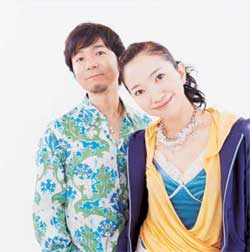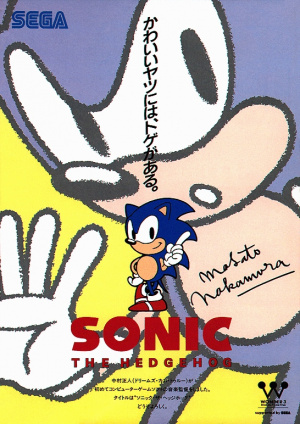Dreams Come True
From Sonic Retro
Dreams Come True (ドリームズ・カム・トゥルー) is an influential music duo from Japan, formed in 1988. They are renowned for their melodies and poetic songwriting, and have sold more than 50 million records worldwide.
Contents
- 1 History
- 2 Involvement in the Sonic the Hedgehog series
- 3 Songs from Dreams Come True's repertoire which use musical material from Sonic
- 4 Masato Nakamura: Production History
- 5 Masato Nakamura: Song Credits
- 6 Miwa Yoshida: Production History
- 7 Miwa Yoshida: Song Credits
- 8 Interviews
- 9 External Links
History
Dreams Come True was started by Masato Nakamura, and is fronted by Miwa Yoshida, who is the band's main songwriter. They were originally a three-piece band with Takahiro Nishikawa on keyboards, until he departed in 2002. The band is commonly known as DCT (Dreams Come True) and sometimes referred to as "Dorikamu" (ドリカム) by their fans. Dreams Come True released their self-titled debut album in 1989, which sold more than one million copies.
In 1993 they recorded "Winter Song" for the opening theme of Tristar Pictures' romantic movie "Sleepless in Seattle" and the following year recorded the song "Eternity" for the animated film "The Swan Princess" by New Line Cinema. In Japan, they recorded many theme songs for Tokyo Broadcasting System television shows, and it wasn't long before they caught the attention of the Walt Disney Company, and were hired to create various musical-tunes for their television shows, and attractions at the Tokyo Disney Resort. In 2001, they composed the theme song for the Disney film "Atlantis", and Miwa was hired to be the voice actor for the character Audrey Rocio Ramirez in the Japanese version.
Masato Nakamura was hired to compose the music for a few television commercials, and around the same time compiled various "Dreams Come True" songs for the Konami corporation to be used in their game series Dance Dance Revolution. He has previously composed the music for the Sonic the Hedgehog video games on the Sega Mega Drive.
They have also been involved in various charity events. Included among these are a collaboration with Ryuichi Sakamoto in 2001 to help raise funds for land mine removal agencies, and taking part in the Live 8 benefit concert in 2005.
Involvement in the Sonic the Hedgehog series
Nakamura was picked by SEGA to compose the music for the original Sonic the Hedgehog early in Dreams Come True's career, in 1990. Later that year, on November 7, Sonic was revealed for the first time by being painted on the side of the band's tour bus. Sega.com interviewed Masato Nakamura about the process of writing music for the game.
| “ | Sega.com: Were you a bit lost, seeing as this was your first time handling video game music?
Sega.com: And so you really put your heart into making the music for 'Sonic,' then?
|
„ |
| — Sega.com interview, Sonic Central | ||
The success of Sonic the Hedgehog's soundtrack led Sonic Team to ask Nakamura to compose the soundtrack of Sonic the Hedgehog 2. SEGA later dropped Masato Nakamura for Sonic the Hedgehog 3 due to financial disagreements, and hired a selection of other composers to make the music. For Sonic the Hedgehog CD and most of the other Sonic games, SEGA used composers at their music studio, Wave Master.
In 2006, Dreams Come True collaborated with Senegalese-American R&B singer/rapper Akon to do a remixed version of "SWEET SWEET SWEET" and "SWEET DREAMS" (the song the Sonic 2 ending is based on in both English and Japanese) for the end theme to the Xbox 360/PlayStation 3 video game Sonic the Hedgehog. The songs were also released as a CD single in Japan.
Songs from Dreams Come True's repertoire which use musical material from Sonic
| Song | Album Info | Player | Sonic song | Description |
|---|---|---|---|---|
| "Marry Me?" | Sing Or Die (1997) Track 9 |
Green Hill Zone | Bizarre title, yet the whole piece is essentially green hill zone played slower and in a different style. Have a listen! | |
| "Kusuriyubi no Kesshin" ("Million Kisses") | Million Kisses (1991) Track 6 |
Star Light Zone | You have to listen very closely to this one, sometimes people argue that it sounds nothing like the song to them, but judge for yourself. The verses rather than the chorus contain the resemblance. | |
| "Sweet Sweet Sweet" | The Swinging Star (1992) Track 11 |
Sonic 2 Ending Theme | This is probably most famous reused track. "Sweet Sweet Sweet" features the same recognizable riff and melody as the Sonic 2 ending but is performed live with vocals! |
Variations of "Marry Me?" and "Sweet Sweet Sweet" have been released in English. "Marry Me?" was included in "Sing Or Die ~International Edition~", a direct translation of the album, while "Sweet Dreams", the English variation of "Sweet Sweet Sweet" was used as the b-side of the Dreams Come True single "Winter Song".
Masato Nakamura: Production History
- Sonic the Hedgehog (Mega Drive Version) (1991) — Sound Produce
- Sonic the Hedgehog (Master System Version) (1991) — Sound Produce
- Sonic the Hedgehog (Game Gear Version) (1991) — Sound Producer
- Sonic the Hedgehog 2 (Mega Drive Version) (1992) — Music Composer
- Sonic Jam (1997) — Music Composer (Sonic the Hedgehog 2 CF)
- Sonic Advance (2001) — composed and arranged by (Scrap Brain Zone, Star Light Zone, Power Up, Boss [from Sonic the Hedgehog]; Emerald Hill Zone (2P), Boss [from Sonic the Hedgehog 2])
- Sonic the Hedgehog (2006) — Music (Sweet Sweet Sweet - 06 Akon Mix -), Backing Vocals (Sweet Sweet Sweet - 06 Akon Mix -), Music (Sweet Dream - 06 Akon Mix -), Backing Vocals (Sweet Dream - 06 Akon Mix -)
- Sonic the Hedgehog Genesis (2006) — Composer Remodeling/Sound Remodeling
- Mario & Sonic at the Olympic Games (2007/2008) — Sonic the Hedgehog Original Music by
- Super Smash Bros. Brawl (2008) — Supervisor (Original Games)
- Super Smash Bros. for Nintendo 3DS (2014) — Supervisor (Original Games)
- Super Smash Bros. for Wii U (2014) — Supervisor (Original Games)
- Sonic Mania (2017) — Composed by (Green Hill Zone, Chemical Plant Zone, Oil Ocean Zone) (Original Music)
The following games credit a "Masato Nakamura", but it is as of yet unconfirmed that it is the same Masato Nakamura of Dreams Come True.
- Final Fantasy VIII (1999) — Action Actor
- Virtua Fighter 4 (2003) — Supervisor (Help Team)
Masato Nakamura: Song Credits
Sonic the Hedgehog (Mega Drive Version)
- Title — Music & Arrangement
- Green Hill Zone — Music & Arrangement
- Marble Zone — Music & Arrangement
- Spring Yard Zone — Music & Arrangement
- Labyrinth Zone — Music & Arrangement
- Star Light Zone — Music & Arrangement
- Scrap Brain Zone — Music & Arrangement
- Boss — Music & Arrangement
- Stage Clear — Music & Arrangement
- Special Stage — Music & Arrangement
- Power Up — Music & Arrangement
- 1up — Music & Arrangement
- Game Over — Music & Arrangement
- Continue — Music & Arrangement
- Final Zone — Music & Arrangement
- All Clear — Music & Arrangement
- Staff Roll — Music & Arrangement
Sonic the Hedgehog 2 (Mega Drive Version)
- Title — Music & Arrangement
- Option — Music & Arrangement
- Emerald Hill Zone — Music & Arrangement
- Chemical Plant Zone — Music & Arrangement
- Aquatic Ruin Zone — Music & Arrangement
- Casino Night Zone — Music & Arrangement
- Hill Top Zone — Music & Arrangement
- Mystic Cave Zone — Music & Arrangement
- Oil Ocean Zone — Music & Arrangement
- Metropolis Zone — Music & Arrangement
- Special Stage — Music & Arrangement
- Power Up — Music & Arrangement
- Super Sonic — Music & Arrangement
- Sky Chase Zone — Music & Arrangement
- Wing Fortress Zone — Music & Arrangement
- Boss — Music & Arrangement
- Death Egg Zone (Part 1) — Music & Arrangement
- Death Egg Zone (Part 2) — Music & Arrangement [NOTE: Also known as "Final Boss"]
- All Clear — Music & Arrangement
- Staff Roll — Music & Arrangement
- Emerald Hill Zone (2P) — Music & Arrangement
- Casino Night Zone (2P) — Music & Arrangement
- Mystic Cave Zone (2P) — Music & Arrangement
- Game Results — Music & Arrangement
- Unused Song — Music & Arrangement [NOTE: Also known as "Hidden Palace Zone"]
Sonic the Hedgehog
- Sweet Sweet Sweet -06 Akon Mix- — Music, Backing Vocals (w/Miwa Yoshida)
- Sweet Dream -06 Akon Mix- — Music, Backing Vocals (w/Miwa Yoshida)
Miwa Yoshida: Production History
- Sonic the Hedgehog (2006) — Lyrics (Sweet Sweet Sweet - 06 Akon Mix -), Vocal, Backing Vocal, Vocal Arrangement (Sweet Sweet Sweet - 06 Akon Mix -), Lyrics (Sweet Dream - 06 Akon Mix -), Vocal, Backing Vocal, Vocal Arrangement (Sweet Dream - 06 Akon Mix -)
Miwa Yoshida: Song Credits
Sonic the Hedgehog
- Sweet Sweet Sweet -06 Akon Mix- — Lyrics, Vocal, Backing Vocals (w/Masato Nakamura), Vocal Arrangement
- Sweet Dream -06 Akon Mix- — Lyrics (w/Mike Pela), Vocal, Backing Vocals (w/Masato Nakamura), Vocal Arrangement

